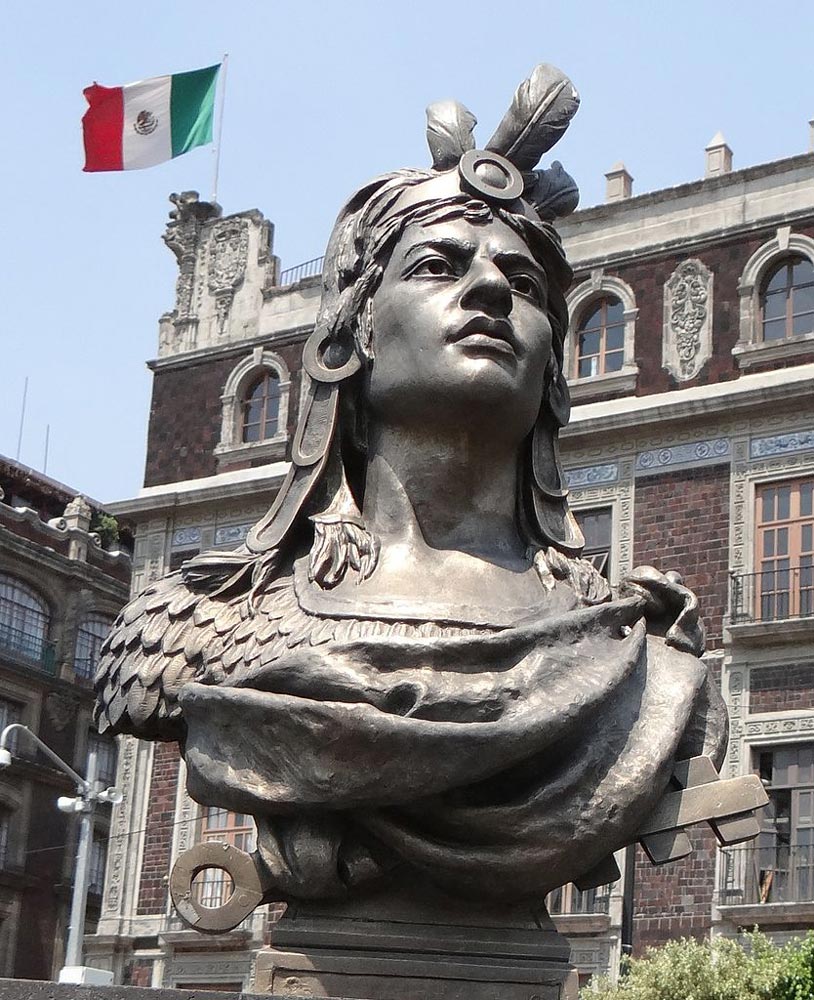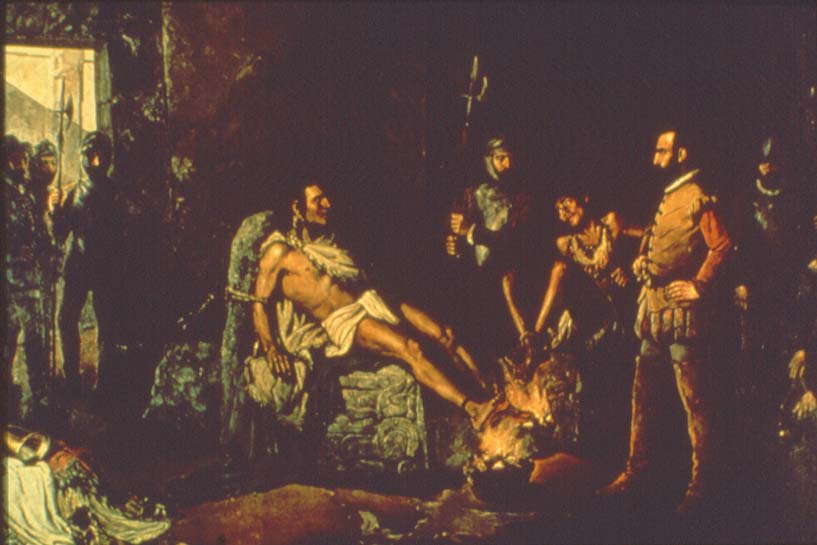| Cuauhtémoc | |
|---|---|
 |
|
| Tenochtitlan (Aztec) Ruler | |
| In Power | 1520 – 1521 |
| Born | c. 1495 |
| Died | Feb. 28, 1525 (at age 29–30) |
| Nationality | Aztec |
| Father | Ahuitzotl |
| Mother | Tlilancapatl |
Cuauhtémoc (c. 1495-1525) was the last emperor of the Aztec city-state of Tenochtitlan, ruling from 1520 to 1521. Only 25 years old when he came to power, he was immediately thrust into a desperate defense of the city against the invading Spanish conquistadors. Today, Cuauhtémoc is considered to be one of the most important symbols of Mexico, also representing the indigenous people of the area.
Early Life
It was thought that Cuauhtémoc was born in 1495, although the exact date is not known. His bearing impressed many who saw him. The Spanish writer Bernal Diaz de Castillo wrote in his book, History of the Conquest, that he was “elegant in his person” for an Aztec. Since Spaniards often denigrated the appearance and abilities of the Aztecs, this was notable praise.
Cuauhtémoc was the nephew of two previous emperors, the renowned ruler, Moctezuma II, and his brother, Cuitlahuac. Since Cuauhtémoc had previously married Princess Tecuichpo, the daughter of Moctezuma, he was also that ruler’s son-in-law. He is known to have had military experience from a young age, although again the precise details are lost. He is also said to have burned with a fiery hatred for the Spaniards.
Rising to Power
The first incident through which Cuauhtémoc became more widely known is not definitely attested by reliable sources, but has come to be seen as indicative of his character. The royal palace of the Aztecs had been taken by the Spaniards, and Moctezuma had been captured by them. At this point, two rival groups of Spanish soldiers clashed, an incident which resulted in the death of the emperor.
The Spanish governor of Cuba, Diego Valazquez, had become jealous of the conquistador Hernán Cortés and ordered a force to Mexico to overthrow him. Cortés took some of his soldiers to repel this attack, but left a substantial force behind in Tenochtitlan. After returning, he was shocked to find out that Pedro de Alvarado, his lieutenant, had had six hundred members of the Aztec nobility killed.
This brutal action pushed the Aztecs into full-scale rebellion, and their forces laid siege to the palace. Cortés told Moctezuma that he must command his subjects to cease their assault, but the people instead showered him with stones. Some of these hit Moctezuma, giving him injuries that he later died from. Legend has it that it was Cuauhtémoc who had provoked the stone-throwing by defiantly waving a javelin towards Moctezuma.
Rise to Emperor
After Moctezuma’s death, Cuitlahuac became emperor. The new ruler did not share Moctezuma’s fear of Cortés, since he did not believe the legend that the Spaniards had been sent by Quetzalcoatl, a god who had fair skin and a beard. Cuitlahuac then died after only four months of his reign, possibly by smallpox – a disease which had been imported to the Americas by the Europeans.
Despite his short tenure as emperor, Cuitlahuac was successful in clearing Tenochtitlan of the conquistadors. In July of 1520, on the Noche Triste (sad night) the Spaniards were driven from the city. Shortly after this, the emperor died and Cuauhtémoc was chosen by a council of nobles to rule in his stead. His most pressing task would be to defend Tenochtitlan, which Cortés was already preparing to attack again.
The Spanish invaders had made an uneasy alliance with the Tlaxcalans, who had an ancient enmity with the Aztecs and allowed the Spaniards to base themselves in their territory. Cortés’ plan was to build ships and launch a large-scale naval attack on the city, which in the 16th century was on the shores of a substantial lake. Before launching the attack, Cortés have Cuauhtémoc a final opportunity to surrender to the Spanish.
Battle Commences
Cuauhtémoc refused to countenance surrendering to Cortés’s army. Furthermore, he inflamed the situation by making a decree that anyone discovered in his realm who had converted to Christianity would be sacrificed. Seeing this defiance from his opponent, Cortés mounted his initial attack some-time in March, 1521, at first planning to bring the Valley of Mexico, which was close to Tenochtitlan, under his control.
The Spanish soldiers reached Tacuba, adjacent to the capital city, but were driven back by Cuauhtémoc, who relied on both land and naval forces in a strong counter-attack. The Europeans were on the defensive, but then reinforcements from Hispaniola arrived. This provided Cortés with 200 soldiers, 80 horses – and, crucially, ammunition. With these resources behind him, Cortés’s men were able to bring the Valley of Mexico completely under their control.
The Final Assault
The Spanish were now able to launch a full-scale assault. On April 28, 1521, the brigantines they had constructed were launched, and a few days later ground troops joined the attack. Cuauhtémoc quickly realized that his troops, who lacked horses, were little more than sitting targets for the Spaniards in open terrain. He therefore changed tactics and brought his soldiers back into Tenochtitlan itself.
Cuauhtémoc’s plan was to fight the invading conquistadors at close quarters, in the streets that the Aztecs knew intimately. At first, the tactic was brilliantly successful: the Spanish assault was driven back beyond the city gates, all the way to the siege lines that had been prepared earlier. Cortés, however, then changed his own approach, deciding to attack the Aztecs’ food supplies.
Assisted by their Tlaxcalan allies, the Spaniards seized control of the city’s main market, threatening the city’s defenders with starvation and famine. Cuauhtémoc responded by attempting to raise a new army from rural areas, in order that they could come to the aid of the starving city residents. His plan was never fully put into practice, however, as he was captured while making a crossing of the lake.
Capture and Torture
 The capture of Cuauhtémoc immediately brought an end to any significant resistance from the Aztecs. Cortés, mindful of his reputation for chivalry, initially treated his prisoner with a degree of honor. However, under pressure from his avaricious royal treasurer, Aldrete, he later permitted Cuauhtémoc to be tortured, with the hope that he might break and reveal the location of any treasure he had hidden from the invaders.
The capture of Cuauhtémoc immediately brought an end to any significant resistance from the Aztecs. Cortés, mindful of his reputation for chivalry, initially treated his prisoner with a degree of honor. However, under pressure from his avaricious royal treasurer, Aldrete, he later permitted Cuauhtémoc to be tortured, with the hope that he might break and reveal the location of any treasure he had hidden from the invaders.
Cuauhtémoc refused to buckle even under repeated bouts of torture, repeatedly stating that he did not know about any hidden treasure. Eventually, having become ashamed of what he had allowed to be inflicted on his vanquished enemy, Cortés reversed his earlier decision and forced Aldrete to stop the infliction of such torture.
Later Life and Death
By 1525, Cuauhtémoc had become an auxiliary soldier under Cortés, and was serving with the Spaniard’s army as it pushed into Honduras. Despite his ability, Cortés was convinced by an Indian convert to Christianity that Cuauhtémoc was a traitor who was plotting against him. Cortés instigated a treason trial for the Aztec, and he was found guilty and sentenced to die by hanging.
The decision did not meet with universal acclaim even among the Spanish – Bernal Diaz de Castillo was among a number who believed that he had been unfairly condemned. Nevertheless, Cuauhtémoc was indeed executed later in 1525. In his last speech, he told Cortés that he had known all along that he had been destined for such a fate, thanks to the “false promises” that Cortés had made.